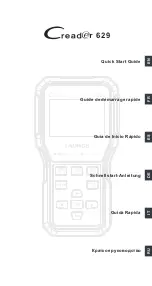
Owner’s Guide
27
The 75 Hz oscillator supplies a near-square wave, low-impedance, low-voltage signal (22
mV
rms
) to an electrode on a finger of the subject. If the skin has measurable conductance
(rather than behaving as an insulator), then current flows, from an electrode on another
finger of the subject, into the very low impedance input of the transimpedance amplifier.
The transimpedance amplifier converts current to voltage. The current will change
as the autonomic reflexes change the skin’s conductivity. The resulting signal is
passed through a synchronous rectifier to obtain a DC voltage proportional to skin
conductance, then via a modulator to produce a 400 Hz AC signal suitable for passing
across the isolation barrier (providing electrical protection for the subject).
On the other side of the isolation barrier, the AC signal is multiplied then synchronously
rectified, restoring a DC voltage proportional to skin conductance. To reduce noise in the
rectified signal, it is passed through a 1 Hz, second-order, low-pass filter, which leaves
the general signal trends unchanged, but removes higher-frequency fluctuations. The
signal at this point consists of the overall (baseline) skin conductivity plus a component
representing the Féré eff ect changes, or galvanic skin response (GSR).
A precision ×1 instrumentation amplifier compares the signal with the output of the
12-bit digital-to-analog converter (DAC). The DAC provides an exact off set voltage for
zeroing and off setting of the synchronously demodulated and filtered signal. This
ensures maximum signal-to-noise ratio, good zeroing resolution, and maximum
resolution in the displayed signal. The DAC removes the constant baseline, allowing just
the fluctuations to be observed.
The control for off setting and zeroing functions in the GSR Amp is provided by an on-
board microcontroller, which also communicates with the PowerLab over the I
2
C bus.
Troubleshooting
This section describes most of the common problems that can occur when using the
GSR Amp with your PowerLab recording unit. If the solutions here do not work, earlier
chapters, the LabChart Help Center, and the guide to your PowerLab may contain
possible remedies. If none of the solutions here or elsewhere are of help, then consult
your ADInstruments representative.
Most of the problems that users encounter are connection problems, and can usually be
fixed by checking connections and starting up the hardware and soft ware again. Very
rarely will there be an actual problem with the front-end or the PowerLab itself.
Problems and Solutions
The status indicators fail to light when the soft ware is started, or the front-end commands
and so on do not appear where they should
The I
2
C cable or the BNC-to-BNC cable from the front-end to the PowerLab is not
connected, has been connected incorrectly (to the wrong input or output, for instance),
or is loose.
Содержание FE231
Страница 1: ...Owner s Guide AMPLIFIER GALVANIC SKIN RESPONSE ...
Страница 17: ...Owner s Guide 17 ...







































